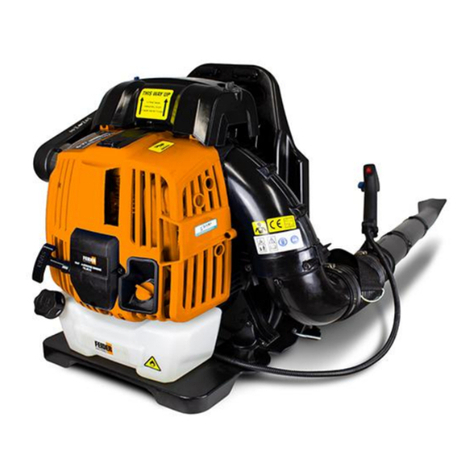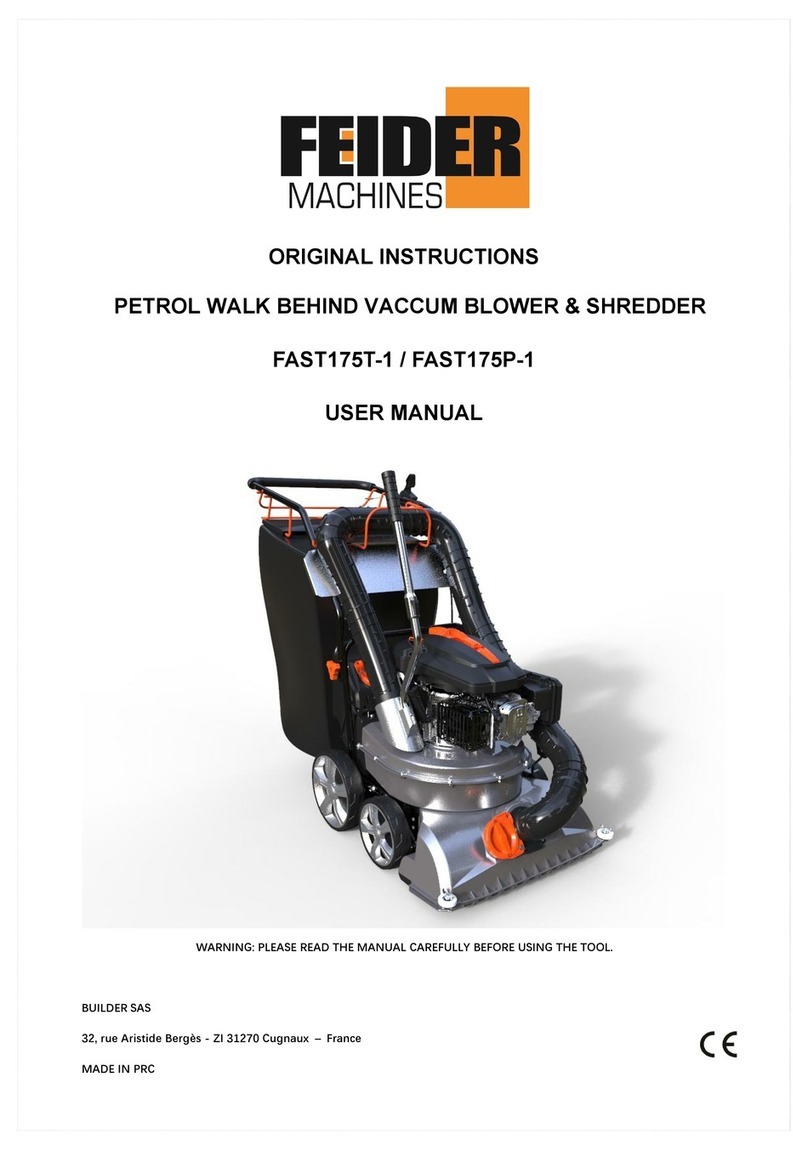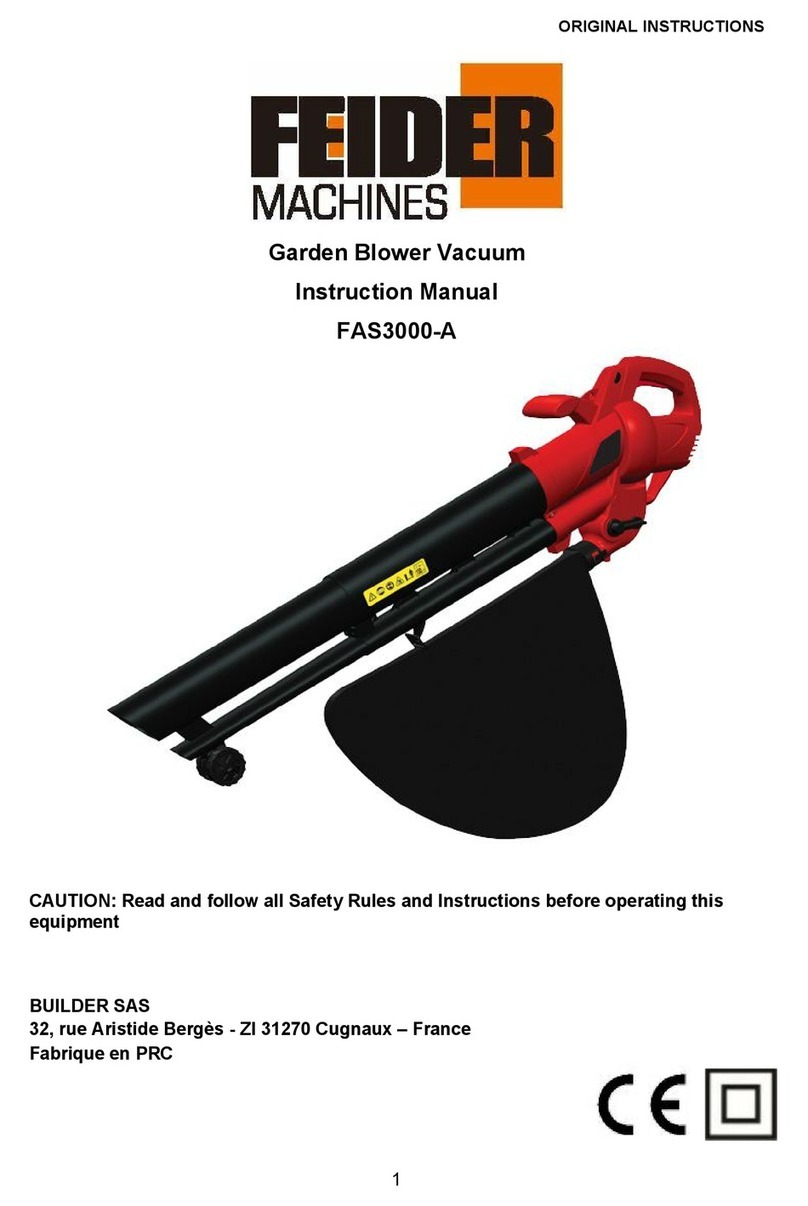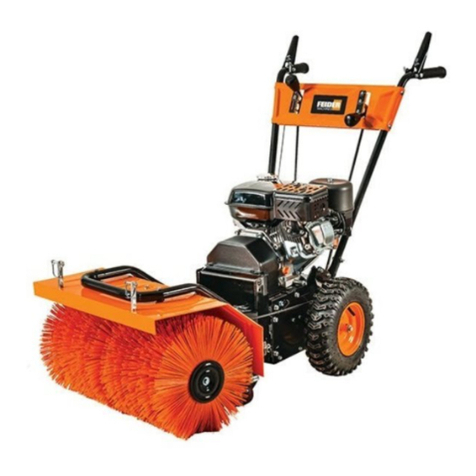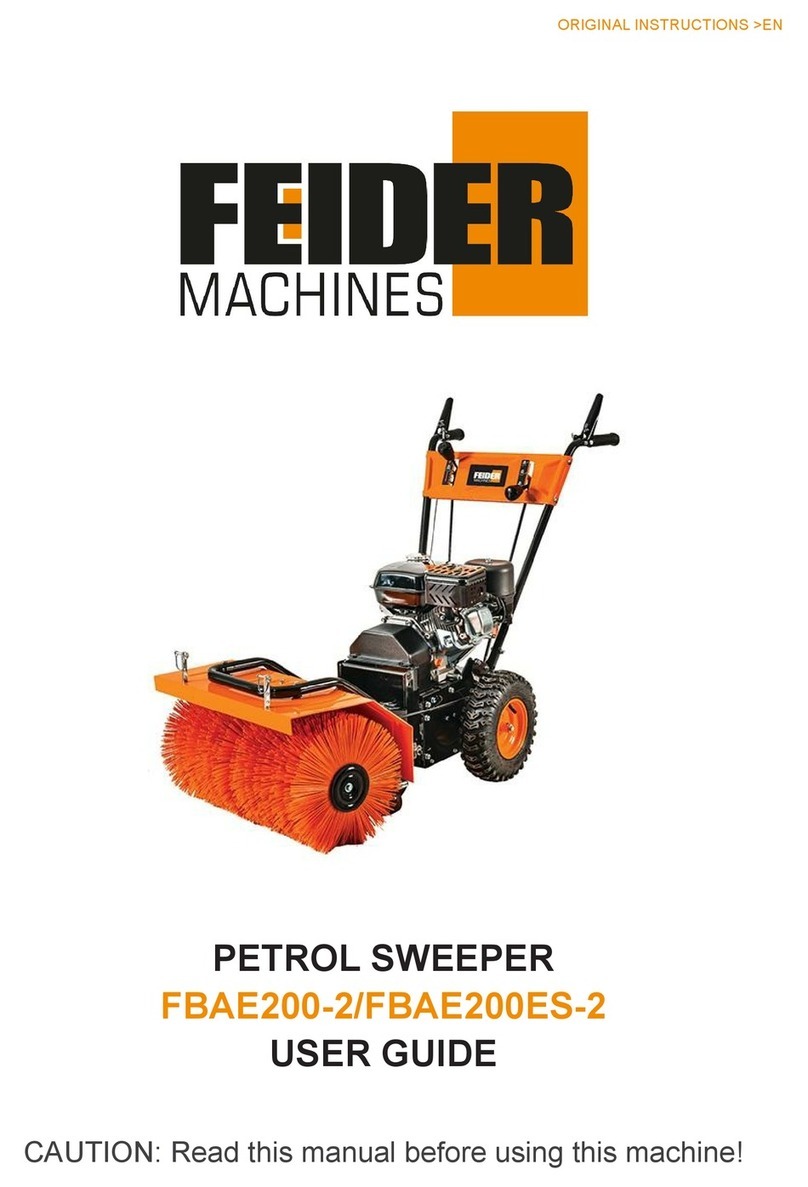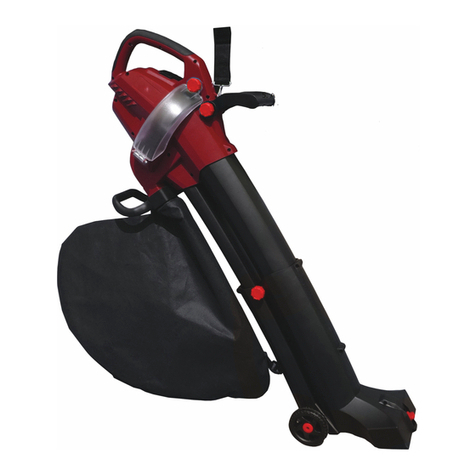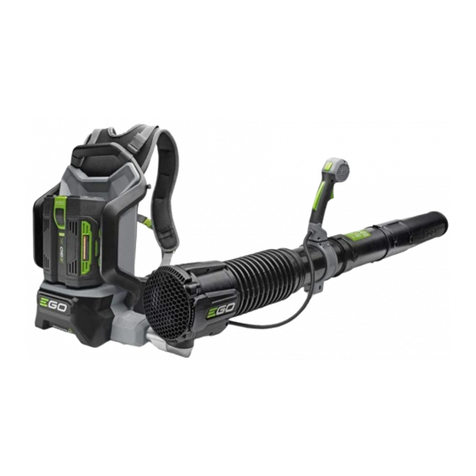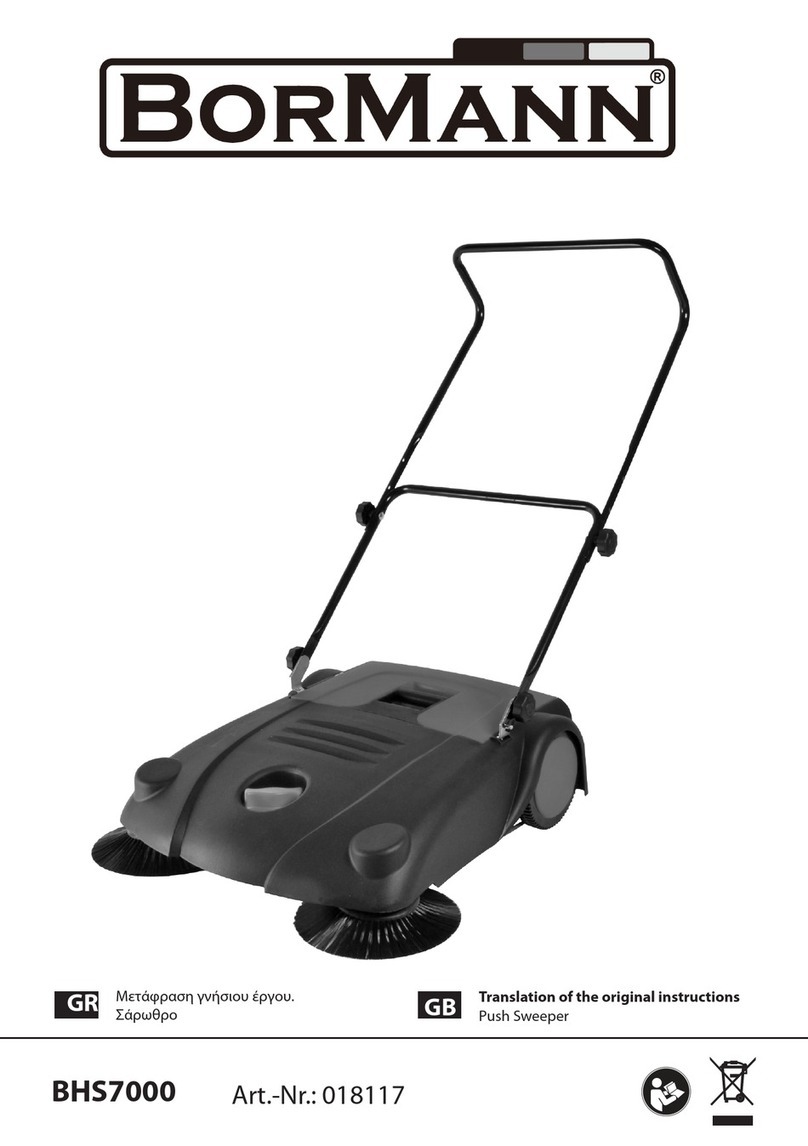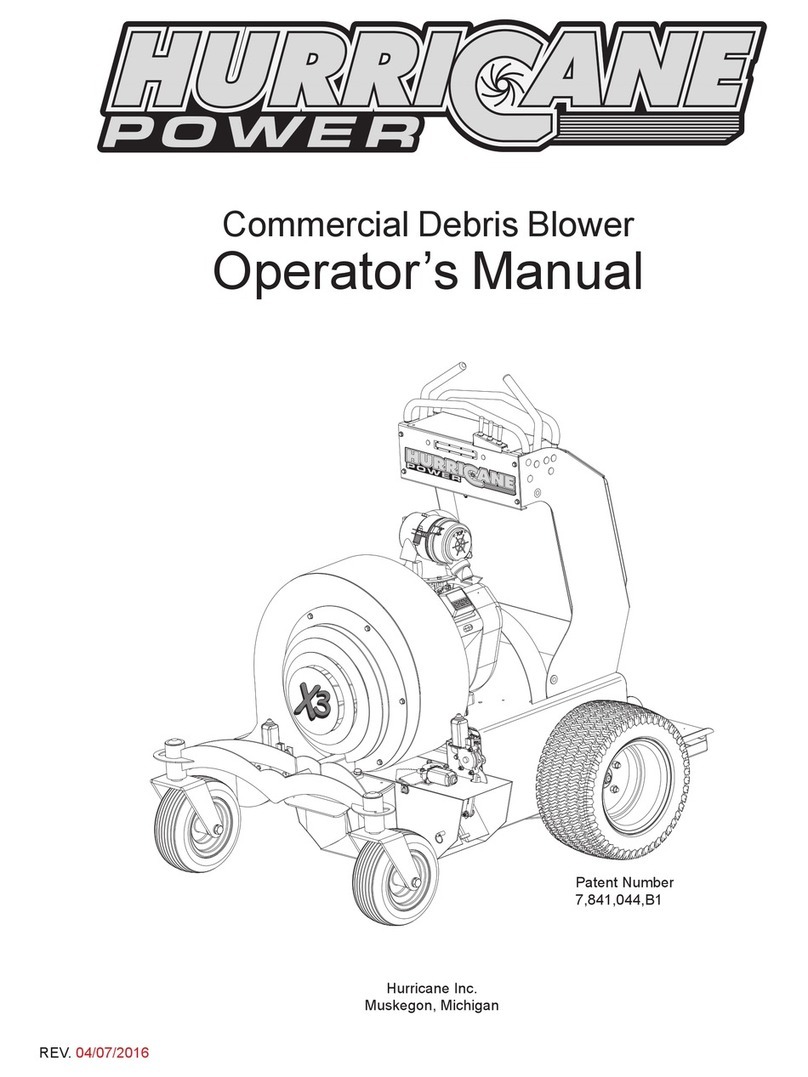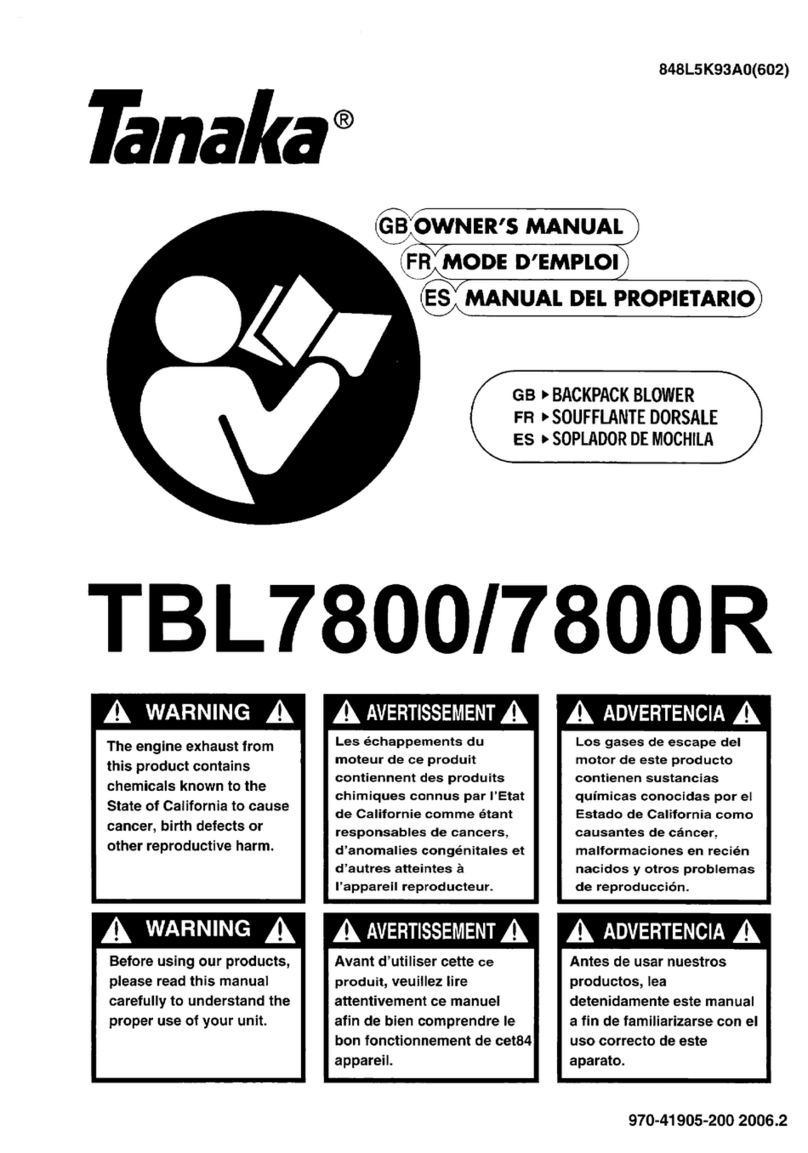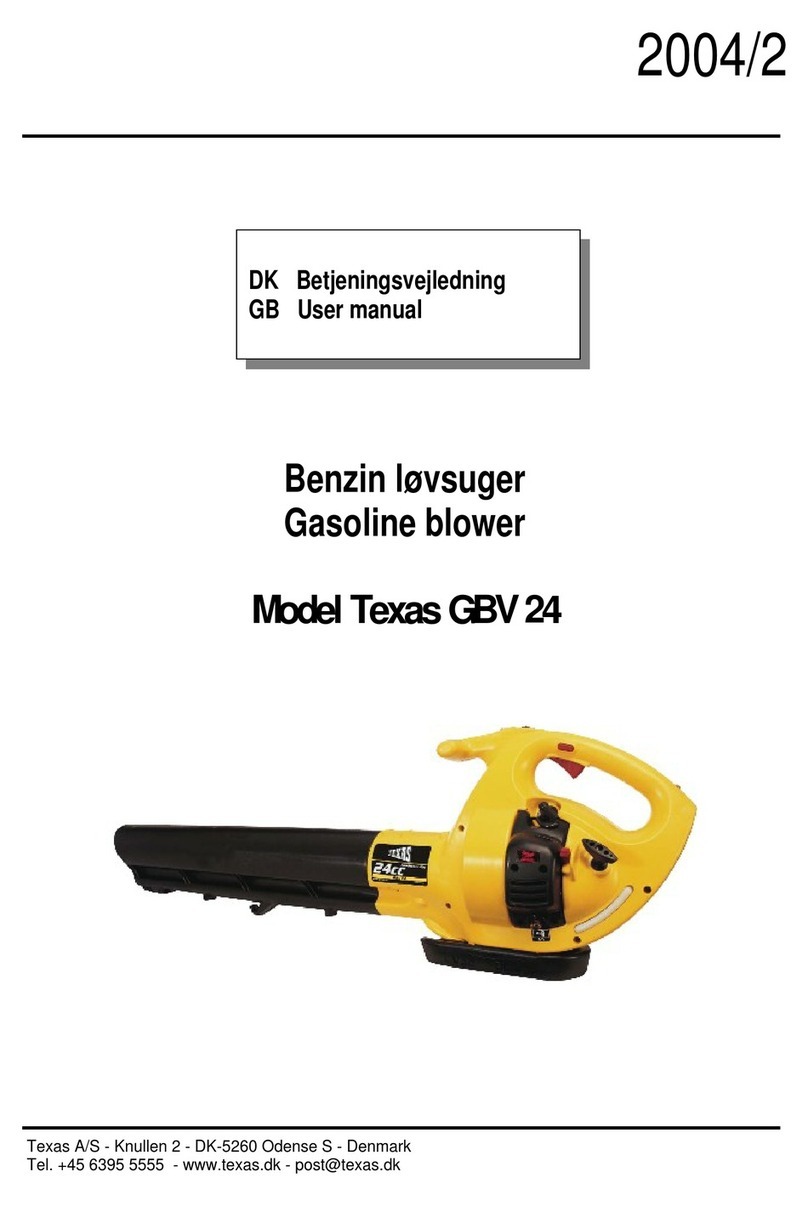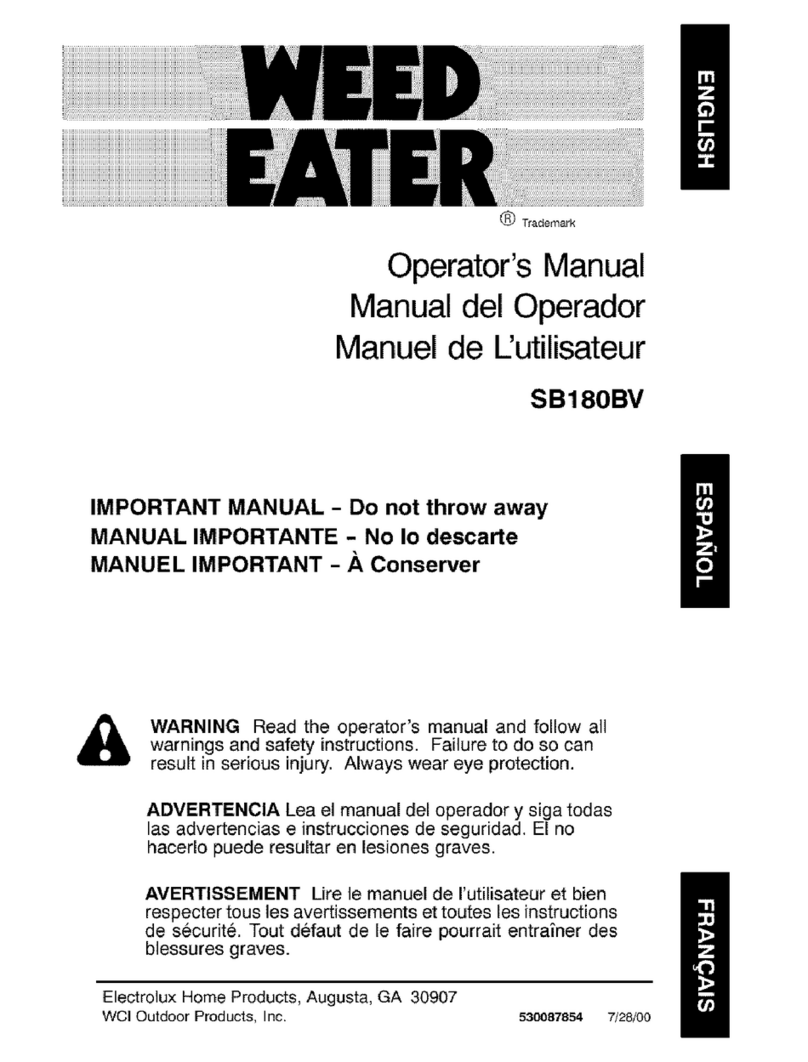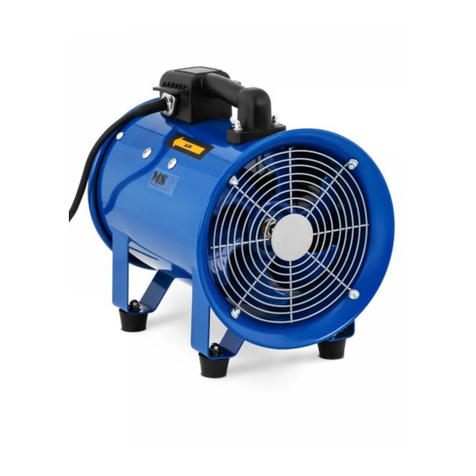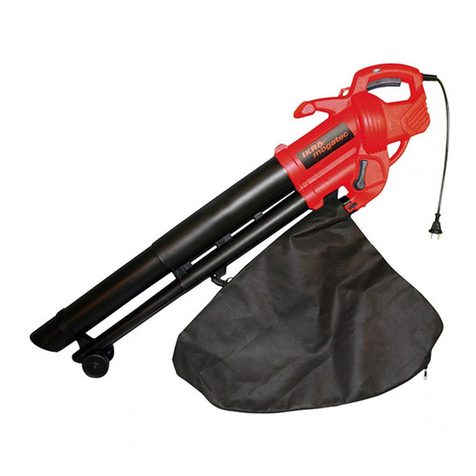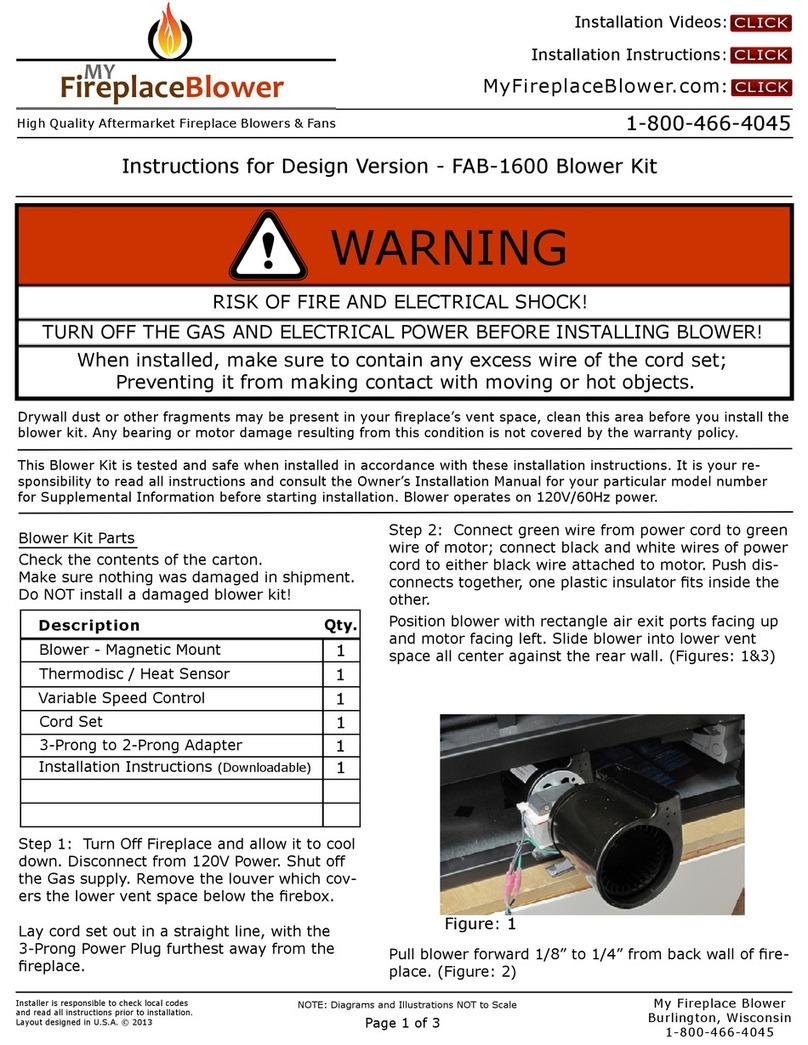Feider Machines FBAE200-1 User manual

ORIGINAL INSTRUCTIONS
INSTRUCTIONS MANUAL
PETROL SWEEPER
Warning: Please read this manual carefully before using the equipment!
BUILDER SAS
32, rue Aristide Bergès - ZI 31270 Cugnaux – France
Made in PRC
01
FBAE200-1 / FBAE200ES-1

HAZARD SYMBOLS AND MEANINGS
WARNING!
WARNING! Read the instructions before operating
the machine.
DANGER! Ejected objects. Do not turn the brush towards
onlookers or animals.
DANGER! Keep people, children and animals away from the
work area.
DANGER! Always use hearing protectors. Wear ear
protection against noise
DANGER! Always use eye protectors. Wear eye protections.
Guarantee sound power level
02

INTRODUCTION
Please read this entire manual prior to operating the equipment. It instructs you how to safely and
easily set up, operate and maintain your machine. Please be sure that you, and any other persons
who will operate the machine, carefully follow the recommended safety practices at all times. Failure to
do so could result in personal injury or property damage.
Function of Sweeper
This sweeper is designed solely for the use in clean up, maintenance and similar. And please pay more attention
that NOT for small stone cleaning, to avoid the injury.
Use in any other way is considered contrary to the intended use. Compliance with and strict adherence to
operation, service and repair conditions, as specified by the manufacturer, are also essential elements of the
intended use.
Terms used in Manual
Right-hand, left-hand, front and rear are determined from actual operating position.
SAFETY STATEMENTS
DANGER
THIS STATEMENT IS USED WHERE SERIOUS INJURY OR DEATH WILL RESULT IF THE INSTRUCTIONS
ARE NOT FOLLOWED PROPERLY.
WARNING
THIS STATEMENT IS USED WHERE SERIOUS INJURY OR DEATH COULD RESULT IF THE INSTRUCTIONS
ARE NOT FOLLOWED PROPERLY.
CAUTION
THIS STATEMENT IS USED WHERE MINOR INJURY COULD RESULT IF THE INSTRUCTIONS ARE NOT
FOLLOWED PROPERLY.
NOTICE
THIS STATEMENT IS USED WHERE EQUIPMENT OR PROPERTY DAMAGE COULD RESULT IF THE
INSTRUCTIONS ARE NOT FOLLOWED PROPERLY.
THIS SYMBOL BY ITSELF OR USED WITH A SAFETY SIGNAL WORD THROUGHOUT THIS MANUAL IS
USED TO CALL YOUR ATTENTION TO INSTRUCTIONS INVOLVING YOUR PERSONAL SAFETY OR THE
SAFETY OF OTHERS. FAILURE TO FOLLOW THESE INSTRUCTIONS CAN RESULT IN INJURY OR DEATH.
03

GENERAL SAFETY PRECAUTIONS
WARNING
READ MANUAL PRIOR TO INSTALL
Improper installation, operation, or maintenance of this equipment could result in serious injury or death.
Operators and maintenance personnel should read this manual as well as all manuals related to this equipment
and the prime mover thoroughly before beginning installation, operation, or maintenance. Follow all Safety
instructions in this manual.
WARNING
READ AND UNDERSTAND ALL SAFETY STATEMENTS
Read all safety decals and safety statements in all manuals prior to operating or working on this equipment. Know
and obey all regulations, local laws and other professional guidelines for your operation. Know and follow good
work practices when assembling, maintaining, repairing, mounting, removing or operating this equipment.
WARNING
KNOW YOUR EQUIPMENT
Know your equipment’s capabilities, dimensions and operations before operating. Visually inspect your
equipment before you start, and never operate equipment that is not in proper working order with all safety
devices intact. Check all hardware to assure it is tight. Make certain that all locking pins, latches, and connection
devices are properly installed and secured. Remove and replace any damaged, fatigued or excessively worn
parts. Make certain all safety decals are in place and are legible. Keep decals clean, and replace them if they
become worn and hard to read.
WARNING
PROTECT AGAINST FLYING DEBRIS
Always wear proper safety glasses, goggles or a face shield when driving pins in or out or when operation causes
dust, flying debris, or any other hazardous material.
WARNING
LOWER OR SUPPORT RAISED EQUIPMENT
Do not work under raised booms without supporting them. Do not use support material made of concrete blocks,
logs, buckets, barrels or any other material that could suddenly collapse or shift positions. Make sure support
material is solid, not decayed, warped, twisted, or tapered. Lower booms to ground level or onto blocks. Lower
booms and attachments to the ground before leaving the cab or operator’s station.
04

GENERAL SAFETY PRECAUTIONS
WARNING
DO NOT MODIFY MACHINE OR ATTACHMENTS
Modifications may weaken the integrity of the attachment and may impair the function, safety, life and
performance of the attachment. When making repairs, use only the manufacturer’s genuine parts, following
authorized instructions. Other parts may be substandard in fit and quality. Never modify any RoPS (Roll over
Protection System) equipment or device. Any modifications must be authorized in writing by the manufacturer.
WARNING
SAFELY MAINTAIN AND REPAIR EQUIPMENT
• Do not wear loose clothing, or any accessories that can catch in moving parts. If you have long hair, cover or
secure it so that it does not become entangled in the equipment.
• Work on a level surface in a well-lit area.
• Use properly grounded electrical outlets and tools.
• Use the correct tool for the job at hand. Make sure they are in good condition for the task required.
• Wear the protective clothing equipment specified by the tool manufacturer.
WARNING
SAFELY OPERATE EQUIPMENT
Do not operate equipment until you are completely trained by a qualified operator in how to use the controls, know
its capabilities, dimensions, and all safety requirements.
• keep all step plates; grab bars, pedals, and controls free of dirt, grease, debris, and oil.
• Never allow anyone to be around the equipment when it is operating.
• Do not allow riders on the attachment or the prime mover.
• Do not operate the equipment from anywhere other than the correct operators position.
• Never leave equipment unattended with the engine running or with this attachment in a raise position.
• Do not alter or remove any safety feature from the prime mover or this attachment.
• Know your work site safety rules as well as traffic rules and flow. When in doubt on any safety issue, contact
your supervisor or safety coordinator for an explanation.
WARNING
FALL HAZARD - DO NOT OPERATE NEAR UNGUARDED EDGES.
• This sweeper is NOT intended for roof top use.
• When operating sweeper, adhere to all government rules, local laws and other professional guidelines for your
05

sweeping application.
- Road surface cleaning shall only be operated by specially trained personnel. The user must know how to
assemble, handle, operate and maintain this machine. People not trained must have a formation given by
a professional.
- Always transport the tool by the handles. Do not lift the tool and do not use any device to transport it.
- Always wear protective equipment, which shall include at least eye protection, hearing protection, helmet,
trousers, and protective shoes.
- If blockage is likely to occur, stop the machine; let the machine cool down. Inspect the machine and
remove the blockage. If machine is damaged do not use it and bring it to specially trained personnel. for
inspection and reparation.
- Maintenance work in hydraulic system is only to be carried out by specially trained personnel.
MAIN COMPONENTS
06

A. Chassis
B. Engine
C. Fuel Tank
D. Handle
E. Dashboard
F. Brush Safety Guard
G. Brush
H. Caster Wheels
I. Wheel
J. Fixing accessories equipment
PACKAGE CONTENTS
Pos.
Description
Qty
A
Handle with pre-installed rods and wires
1
B
Handle fastening screws
4
C
Handle fastening bolts
4
D
Spark plug removal key
1
E
Nuts and bolts
1
07

NOTES:
1. Cautiously open the packaging, paying attention not to lose components.
2. Consult the documentation in the box, including these instructions.
3. Remove all the unassembled parts from the box.
4. Remove the machine from the box.
5. Dispose of the box and packaging in compliance with local regulations.
ASSEMBLY
Please note that during assembly, maybe you’ll need a helper!
1. Forward and brush control cable assembly
Couple the cable eyelet to the specific opening (fig. 3).
NOTE: The cables are already pre-assembled on the dashboard.
08

2. Handle assembly
The handle is delivered with the dashboard
already assembled. The machine handle
assembly screws, gear control fastening
screws and nuts and bolts to secure the brush
directional control are delivered in a separate
package found in the machine packaging.
Install as follows:
a) Bring the two tubes at the ends of the
handle (fig. 4.A) up to the support (fig. 4.B).
b) Insert the screws in the holes and secure in
place with the nuts.
3. Installation of the gear control
a) Remove the previously assembled articulated joint (fig. 5.A) on the washer gear
control (fig. 5.B) and nut (fig. 5.C).
b) Insert the articulated joint (fig. 5.A) of the gear control in the hole on the lever (fig.
5.D) to connect it to the transmission.
c) Secure the washer (fig. 5.B) and nut (fig. 5.C).
4. Brush directional control assembly
a) Remove the previously assembled articulated joint (fig. 6.A) on the brush directional
control nut (fig. 6.B).
09

b) Insert the articulated joint (fig. 6.A) on the brush directional control in the lever hole
(fig. 6.C) to connect it to the drive.
c) Secure the nut (fig. 6.B).
ENGINE OPERATION
NOTICE: THE MOTOR IS DELIVERED WITHOUT OIL AND GASOLINE.
Oil Filling:
Place the motor in a horizontal position. Remove the plug and fill with oil right to the edge. (Figure 7)
Fuel
Use lowest available octane unleaded fuel. When filling, place the machine in a horizontal position. Always
replace old fuel. Always stop the motor when fueling. Never fill up with fuel on a hot motor.
Never use gasoline mixed with oil.
Operation - Start and Stop
Cold Motor
Activate the motor choke. Set the throttle control on full speed. (Figure 8) first, pull the starting rope a couple of
times, shortly, until if feels tight. Pull the starting rope slowly to the point where it feels tight, place your left hand
on the motor in order to hold back, and pull the starting rope hard once. When the motor runs, deactivate the
choke.
NOTICE: NEVER LET THE STARTING ROPE WIND AGAIN BY ITSELF.
Follow it all the way back with your hand. If the motor will not run in spite of several attempts this may be caused
by the fact that there is too much fuel in the cylinder/carburetor, and that the spark plug has become moist.
Remove the plug and wipe it off.
Stop the Motor:
Set the throttle control in position “Stop”. Set the throttle lever to idle and let the motor run for 12-20 seconds
before the lever is moved to stop. Never leave the sweeper without stopping the motor.
10

NOTICE: Do not turn off the motor by switching on the choke, as this may result in damage to the motor.
OPERATION
CAUTION
A SWEEPER IS A DEMANDING MACHINE.
Only fully trained operators or trainee operators under supervision of a fully trained person should use this
machine.
Before operating sweeper:
Operate sweeper controls in an off-road location.
Be sure that you are in a safe area, away from traffic or other hazards.
Check all hardware making sure it is tight.
Replace any damaged or fatigued hardware with properly rated fasteners.
Check tire pressure before sweeping.
Remove from the sweeping area all property that could be damaged by flying debris.
Be sure all persons not operating the sweeper are clear of the sweeper discharge area protection; and a dust
mask.
Always wear proper apparel such as a long sleeved shirt buttoned at the cuffs; safety glasses goggles or a
face shield; ear protection; and a dust mask.
11

While operating sweeper
DANGER
FALL HAZARD - DO NOT OPERATE NEAR UNGUARDED EDGES.
This sweeper is not intended for roof top use.
When operating sweeper, adhere to all government rules, local laws and other professional guidelines for
your sweeping application.
Minimize flying debris - use the slowest rotating speed that will do the job.
Keep hands, feet, hair and other loose clothing away from all moving parts.
Before leaving the operator’s position for any reason stop engine.
NOTICE: AVOID TRANSMISSION DAMAGE. Do not shift while in motion.
WARNING
Leave the brush hood (shield) and all other shields and safety equipment in place when operating the sweeper.
When sweeping on rough terrain, reduce speed to avoid “bouncing” the sweeper. Loss of control can result.
Never sweep toward people, buildings, vehicles or other objects that can be damaged by flying debris.
Only operate the controls while the engine is running.
While you operate the sweeper slowly in an open area, check for proper operation of all controls and all
protective devices. Note any repairs needed during operation of the sweeper. Report any needed repairs.
OPERATION
Before each use
Perform daily maintenance as indicated in Maintenance Schedule.
Run the sweeper at a low idle, check for proper brush rotation and drive engagement.
WARNING
AVOID SERIOUS INJURY.
Check for large objects that could harm the operator or others if thrown by the sweeper. Remove these items
before operating.
During use
Directing Debris
Avoid excessive downward pressure on the brush sections to prevent excessive wear. A two to four inch wide
pattern is sufficient for most applications.
Direct debris by angling the brush head in that direction.
Observe wind direction. Sweeping with the wind makes sweeping more effective and helps keep debris off
the operator.
12

The terms swing and angle are used interchangeably.
Brush Direction
The brush direction is regulated by a lever (fig. 9B) that tilts it in the required direction. Move the lever
forward or rear in one of the 3 available positions to tilt the brush.
·Lever forward = 15oto the right.
·Lever central = 0ono tilt.
·Lever rear = 15oto the left.
Sweeping
To sweep:
1. Turn the handle(fig.9A) to control Forward and Rear.
2. Turn the brush directional control (fig. 9 B) to the required
position. (See Brush Direction)
3. Set the gear depending on the route and the amount of
material to be swept.
4. Engage the brush drive. (fig. 9C)
5. Engage the traction drive. (fig. 9D)
NOTICE: AVOID SWEEPER DAMAGE. Reduce travel speed to
avoid hitting immovable objects.
The sweeper is equipped with an instant shutoff, when you release the levers, the brush and machine stop.
Operating Tips
NOTICE: AVOID SWEEPER DAMAGE. Do not ram into piles.
Large areas
For uneven or dirt surfaces, reduce speed to avoid jogging the brush and damaging it.
Sweep creating a central passage dividing the area in 2 parts and then sweeping the remaining areas. This
reduces the load on the brush.
13

OPERATION
Snow
Snow is removed more easily when it is still fresh. Pass back over the already cleared zones to remove snow
residue.
If possible, clear the snow in the direction of the wind. Check the distance and the direction of the removed
snow.
Reduce the engine rotations before stopping it.
Dirt & Gravel
To reduce the amount of duct lifted when sweeping, work at low brush speed. If possible, also work on damp
or cloudy days or after it rains.
For gravel, adjust the height of the brush to avoid throwing them and causing potential damages.
Heavy Debris
Reduce forward speed and work without using the entire machine working width.
WARNING
SAFELY OPERATE EQUIPMENT
Do not operate equipment until you are completely trained by a qualified operator in how to use the controls, know
its capabilities, dimensions, and all safety requirements.
Keep all step plates; grab bars, pedals, and controls free of dirt, grease, debris, and oil.
Never allow anyone to be around the equipment when it is operating.
Do not allow riders on the attachment or the prime mover.
Do not operate the equipment from anywhere other than the correct operators position.
Never leave equipment unattended with the engine running or with this attachment in a raise position.
Do not alter or remove any safety feature from the prime mover or this attachment.
Know your work site safety rules as well as traffic rules and flow. When in doubt on any safety issue, contact
your supervisor or safety coordinator for an explanation.
WARNING
IN AN EMERGENCY, RELEASE LEVERS AS QUICKLY AS POSSIBLE AND STOP THE ENGINE.
14

Height adjustment of Caster Wheels & Brushes
Once the brushes get worn it is necessary to adjust the height of the
brushes, i.e. how close they are to the surface to sweep. This adjustment
takes place by moving the plastic rings of the brush caster wheels. See as
follows:
1. Loosen the side knob (fig. 10.A);
2. Rotate the upper knob (fig. 10.B) in clockwise / anticlockwise to lift /
lower the small wheels;
3. Fix the side knob (fig. 10.A);
Change Attachments
If what you bought is multi-function sweeper &snow thrower, you should change the function by yourself.
Please check below steps for success assembly work.
To Separate Engine part and Attachments (Sweeper / Snow thrower head)
1. If the attachment on the machine is sweeper, please do following first:
a) Remove the B pin (fig.11 A) from the direction bar (fig.11 C);
b) Pull the direction bar (fig.11 C) out from the machine.
c) Click the direction bar (fig.11 C) into hook (fig.11 B) to avoid its moving.
If the attachment on the machine is snow thrower, please skip this step.
2. Hold the handle of the machine steadily.
3. Step the lower pedal (fig.12 A) nearby the connection according to fig.13.
15

16

4. The upper pedal (fig.12 B & fig.13 B) will be released from the connection (fig.12 E).
5. Raise up the engine part to release attachment.
To Connect Engine part with Attachments (Sweeper / Snow thrower head)
1. Put the sweeper / snow thrower head on an open area.
2. If you are going to connect sweeper head, please make sure that both caster wheels (fig.14 B) are on their
highest position (the wheels cannot touch the ground).
3. Hold the handle of the engine part, and move it towards the attachment.
4. Lower the engine part to make the bar (fig.12 C) go into the two hooks (fig.12 D) to interlock gears of two parts.
You will hear an audible “CLICK”.
5. Make sure the two gears are in right position, then press the upper pedal (fig.12 B) towards the link (fig.12 E).
You will hear an audible “CLICK”.
6. If you are connecting snow thrower head, it’s OK for working now.
7. If you are connecting sweeper head, you have to continue the following steps:
a) Remove the direction bar (fig.11 C) from the hook (fig.11 B).
b) Remove the pin (fig.11 A) on the direction bar (fig.11 C).
c) Press the direction bar (fig.11 C) to the hole on the sweeper head.
d) Put the pin (fig.11 A) into the direction bar (fig.11 C).
Then your sweeper is workable now.
17

SERVICE & REPAIR - GENERAL
Repair or adjust the sweeper in a safe area, away from traffic and other hazards.
Before adjusting or servicing remove spark plug wire from spark plug.
STORAGE
NOTICE:
Do not store the sweeper with weight on the brush. Weight will deform the bristles, destroying the sweeping
effectiveness.
Do not store polypropylene brushes in direct sunlight. The material can deteriorate and crumble before the
bristles are worn out.
Keep polypropylene brush material away from intense heat or flame.
TROUBLESHOOTING
The engine does not start
Ensure that the spark plug is not defective
Ensure that the spark plug cap is fitted correctly
The engine runs irregularly
Ensure that the choke is deactivated
Ensure that there are no impurities in the fuel
The brushes will not rotate
Check whether the belt coupling is adjusted correctly.
Check whether the v-belt is defective
The machine will not run
Make sure that the belt coupling is adjusted correctly
The machine does not sweep
effectively
Check whether the v-belt is defective
Check whether the brush distance to the surface is set
correctly
18

MAINTENANCE
MAINTENANCE SCHEDULE
PROCEDURES
BEFORE
EACH USE
25 HOURS
100
HOURS
AFTER
EACH USE
Hardware - Inspect & tighten
Engine & Air Filter - check & clean if
necessary
Oil, engine - check level
Wash Unit - Remove Grease & Debris
Maintenance
If you need to change the belts, please contact the distributor or local agent. Do not change them by yourself.
Residual risks
Even when the machine is used as prescribed it is not possible to eliminate all residual risk factors. The following
hazards may arise in connection with the power tool’s construction and design:
1. Damage to lungs if an effective dust mask is not worn.
2. Damage to hearing if effective hearing protection is not worn.
3. Damages to health resulting from vibration emission if the power tool is being used over longer
period of time or not adequately managed and properly maintained.
WARNING
This machine produces an electromagnetic field during operation. This field may under some circumstances
interfere with active or passive medical implants. To reduce the risk of serious or fatal injury, we recommend
persons with medical implants to consult their physician and the medical implant manufacturer before operating
this machine.
19

TECHNICAL DATA
Measured sound power level: 101.56 dB(A) K=
2,5 dB(A)
Measured sound power level: 101.56 dB(A) K=
2,5 dB(A)
Measured sound pressure level: 87,8 dB(A) K=
2,5 dB(A)
Measured sound pressure level: 87,8 dB(A) K=
2,5 dB(A)
Guarantee noise level: 104 dB(A)
Guarantee noise level: 104 dB(A)
Vibration (L/R): 5,65/4,85 m/s² K= 1,5 m/s²
Vibration (L/R): 5,65/4,85 m/s² K= 1,5 m/s²
Weight: 70 kg
Weight: 72 kg
Engine power: 4,8 kW
Engine power: 4,8 kW
Working width: 80 cm (32’’)
Working width: 80 cm (32’’)
Measurement of the noise emission was made according to requirements of the Directive Machine
2006/42/EC and Noise Emission Directive 2000/14/EC amended by 2005/88/EC.
20
FBAE200-1 FBAE200ES-1
This manual suits for next models
1
Table of contents
Other Feider Machines Blower manuals
